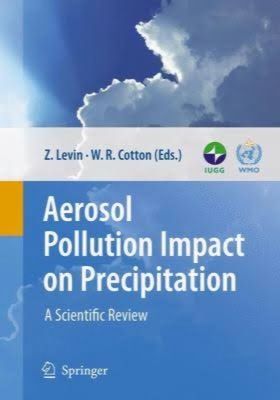Foreword . . . . . . . . . . . . . . . . . . . . . . . . . . . . . . . . . . . . . . . . . . . . . . . . . . xi Preface . . . . . . . . . . . . . . . . . . . . . . . . . . . . . . . . . . . . . . . . . . . . . . . . . . . xiii Executive Summary . . . . . . . . . . . . . . . . . . . . . . . . . . . . . . . . . . . . . . . . . . xv 1 Introduction . . . . . . . . . . . . . . . . . . . . . . . . . . . . . . . . . . . . . . . . . . . . . 1 Leonard A. Barrie, Ulrike Lohmann and Sandra Yuter 2 Principles of Cloud and Precipitation Formation . . . . . . . . . . . . . . . . . 13 William R. Cotton and Sandra Yuter 3 Sources and Nature of Atmospheric Aerosols. . . . . . . . . . . . . . . . . . . . 45 Meinrat O. Andreae, Dean A. Hegg and Urs Baltensperger 4 The Distribution of Atmospheric Aerosols: Transport, Transformation and Removal . . . . . . . . . . . . . . . . . . . . . . . . . . . . . . . . 91 Sunling Gong and Leonard A. Barrie 5 In Situ and Remote Sensing Techniques for Measuring Aerosols, Clouds and Precipitation . . . . . . . . . . . . . . . . . . . . . . . . . . . . . . . . . . . 143 Didier Tanre´ , Paulo Artaxo, Sandra Yuter and Yoram Kaufman 6 Effects of Pollution and Biomass Aerosols on Clouds and Precipitation: Observational Studies . . . . . . . . . . . . . . . . . . . . . . . 205 Zev Levin and Jean-Louis Brenguier 7 Effects of Pollution Aerosol and Biomass Burning on Clouds and Precipitation: Numerical Modeling Studies. . . . . . . . . . 243 Graham Feingold, William Cotton, Ulrike Lohmann and Zev Levin ix 8 Parallels and Contrasts Between Deliberate Cloud Seeding and Aerosol Pollution Effects . . . . . . . . . . . . . . . . . . . . . . . . . . . . . . . 277 William R. Cotton 9 Summary . . . . . . . . . . . . . . . . . . . . . . . . . . . . . . . . . . . . . . . . . . . . . . . 295 10 Recommendations . . . . . . . . . . . . . . . . . . . . . . . . . . . . . . . . . . . . . . . . 301 Appendix A: List of Acronyms Used in the Report . . . . . . . . . . . . . . . . . . 307 References . . . . . . . . . . . . . . . . . . . . . . . . . . . . . . . . . . . . . . . . . . . . . . . . . 313 Index . . . . . . . . . . . . . . . . . . . . . . . . . . . . . . . . . . . . . . . . . . . . . . . . . . . . . 383
Life on Earth is critically dependent upon the continuous cycling of water between oceans, continents and the atmosphere. Precipitation (including rain, snow, and hail) is the primary mechanism for transporting water from the atmosphere back to the Eartha (TM)s surface. It is also the key physical process that links aspects of climate, weather, and the global hydrological cycle. Changes in precipitation regimes and the frequency of extreme weather events, such as floods, droughts, severe ice/snow storms, monsoon fluctuations and hurricanes are of great potential importance to life on the plane.


